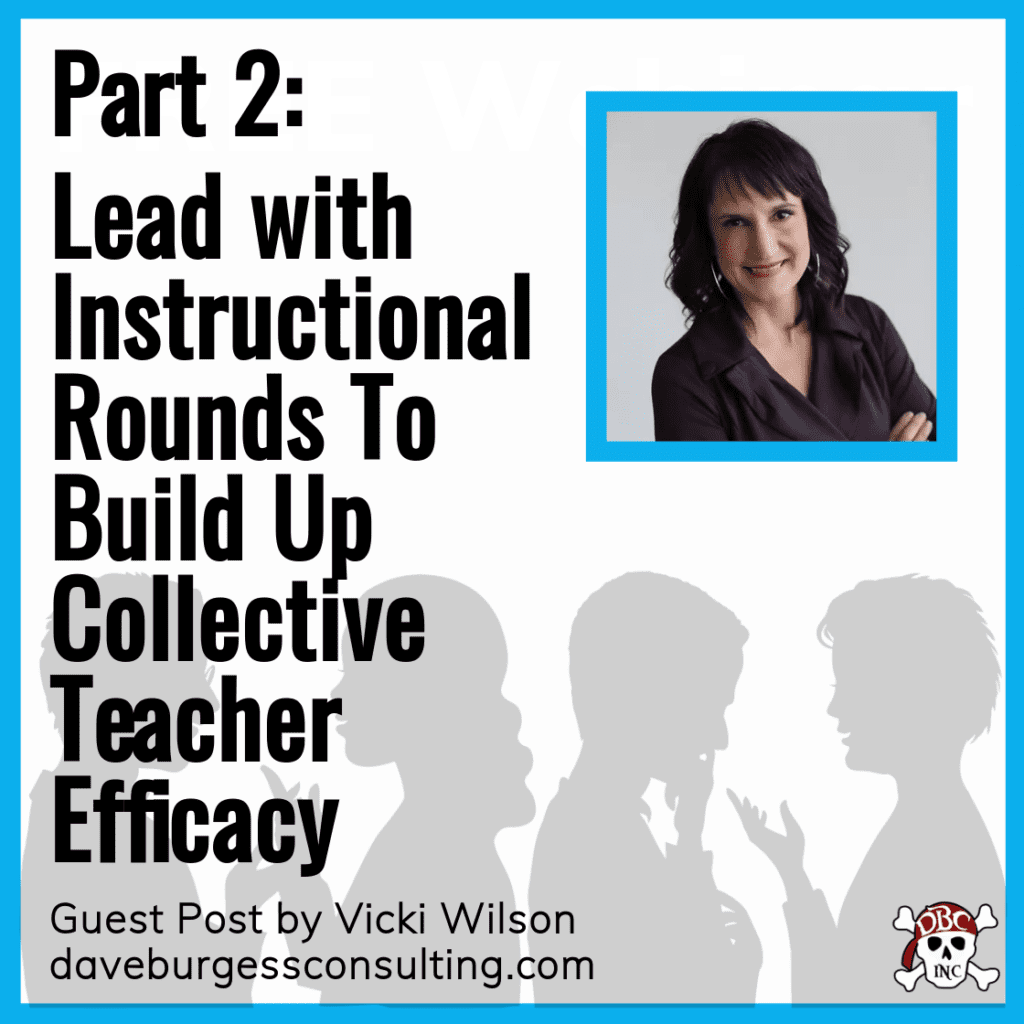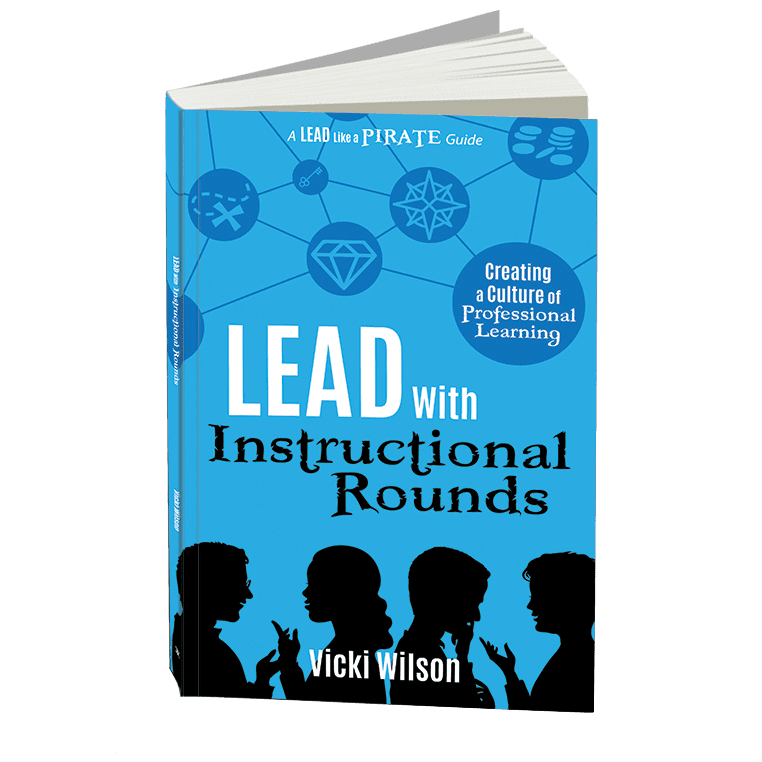Today's guest post is written by an educator who has served children and the field for over 28 years as a teacher and principal--Vicki Wilson. Vicki is passionate about education and strives to make it better every day. She is particularly interested in educator learning, leadership, organizational change, progressive and innovative practices in education, and leveraging best practices at school to improve so that all students get the best possible education.
Vicki is also an incredible wife, mom, and the outstanding DBC, Inc. author of Lead with Instructional Rounds!
We can't wait to learn Part 2 of this series from you, my friend!
Take it away.
Part 2: Guest Post by Vicki Wilson
Have you ever been asked a question that made you pause and reflect on your work? I certainly have, and it happened to me recently when someone inquired if there was anything I would change about my book, “Lead With Instructional Rounds – Creating a Culture of Professional Learning," now that the model is being used more. Without hesitation, I replied, "Yes! I did not quite nail the title." As readers dive into the pages of the book, they will uncover two notable shifts in this approach that set it apart from other models in the field. However, if you judge this book by its cover, or rather its title, you miss out on the transformative insights it offers – which are the keys to enhancing collective teacher efficacy.
The first shift revolves around adopting a strength-focused lens rather than a deficit lens for instructional rounds. The process is designed to create psychological safety, enabling participants to reflect and contemplate their own practices as they conduct brief classroom observations of their colleagues. During these observations, participating teachers are encouraged to identify strong and effective instructional practices and their impact on student learning. Following each observation, facilitators from the group pose reflective questions that foster positive discussions, focusing on the strengths of instruction and its impact on student learning. Gallup’s research has shown that organizations emphasizing employee strengths experience significantly higher levels of employee engagement. Building on employee strengths results in improved performance, well-being, and productivity.
The second shift a reader discovers is that the approach is grassroots, rather than top-down, meaning it is conducted and “owned” at the local school level. Higher-level leadership does not come into schools to audit practice or lead this work. As schools and districts around the world embrace this approach as a systemic initiative, careful thought is given to how it is introduced, maintaining ownership at a building level. Successful districtwide initiatives can preserve this grassroots appeal by respecting building-level control over implementation while providing support through training, resources, time, and the removal of barriers. Just imagine the message of support it would send if a central office leader covered a classroom for 90 minutes to allow a teacher in a school to participate in instructional rounds.
But how do these two shifts create the conditions for greater collective teacher efficacy?
In “Visible Learning: The Sequel,” John Hattie identifies Collective Teacher Efficacy as the number one factor influencing student achievement with a weighted mean effect size of 1.34. Effect size measures the influence a specific practice has on student achievement. An effect size of 0 indicates a practice has no influence on student achievement. The larger the effect size, the more powerful the influence. Hattie identifies three benchmark effect sizes: 0.2 is relatively small, an effect size of 0.4 is medium, and an effect size of 0.6 is large.
Hattie defines collective teacher efficacy as the shared belief by a group of teachers in a particular educational environment that they have the skills to positively impact student outcomes. This grassroot approach of looking at the strengths of each the educators in our school, followed by discussions of the research supporting observed strategies and their impact on student learning, serves as a platform upon which we can build collective teacher efficacy.
In Chapter 1 of “Collective Efficacy, How Educators’ Beliefs Impact Student Learning”, author Jenni Donohoo delves into the literature on collective teacher efficacy. The key to collective efficacy lies in evidence of impact. Our beliefs about our individual and collective capacity to influence learning can be molded. Donohoo shares the work of Bandura and Goddard et al., highlighting four sources that shape collective efficacy beliefs.
The most powerful source is mastery experiences. When teams experience success, and attribute that success to causes within their control, their collective efficacy increases. Teams expect that effective performances can be repeated. Using a strength-focused approach to instructional rounds draws attention to mastery experiences. After a classroom observation, teachers engage in conversation about the impact the effective strategies observed had on the learning of the students in that classroom. This is not about being perfect. In fact, it’s important to acknowledge that we are imperfect people, teaching a room full of imperfect people. Within that space of imperfection, we each have strengths we can call upon to execute effective high-leverage instructional practices – something always within our control.
Vicarious experiences, the second most influential source, occur when teams of educators witness success in environments like their own, strengthening their collective efficacy. When teachers see their colleagues perform well through challenges, they believe they, too, can overcome the obstacles. Instructional rounds, most simply described, is a process for teachers to observe other teachers in their own school. This is a vicarious experience.
Social persuasion, the third source, enhances collective efficacy when groups are encouraged to innovate and overcome challenges by credible and trustworthy sources. Establishing norms of openness, collaboration, and cooperation supports the influence of social persuasion. During instructional rounds, this occurs as we reflect and admire the work of our colleagues while contemplating how we can become better versions of ourselves as teachers and support each other in our own growth journeys.
The fourth, and least influential, source is affective states, which encompass feelings of excitement and anxiety that contribute to the emotional tone of an organization. Drawing upon the norms and agreements that we have established before going on instructional rounds, fosters trust and creates psychological safety for our social persuasion, contributing to a positive affective state that supports adult learning and professional growth.
When a school faculty regularly observes each other and recognizes that each teacher positively impacts student learning through their unique strengths, then engages in dialogues to reflect upon and process effective practices observed and their impact on student learning, they come to realize their interdependence on student success, and their collective efficacy flourishes.
Thank You, Vicki!
Thanks, Vicki! Loved your post!
If you haven't already, follow Vicki and learn more from her by clicking these links X (Twitter) HERE and her website HERE to book her to come out to your learning setting! She's an outstanding professional development speaker!
And, don't forget to preview her amazing DBC, Inc. Book, Lead with Instructional Rounds for FREE by clicking the book title or book image. (Scroll to the bottom of the page and click Preview.)






